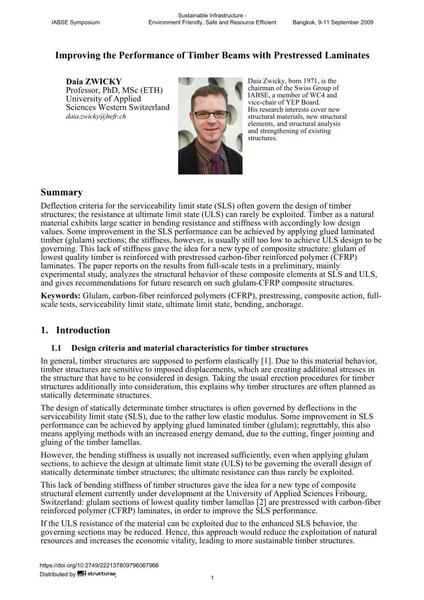Improving the Performance of Timber Beams with Prestressed Laminates

|
|
|||||||||||
Bibliografische Angaben
| Autor(en): |
Daia Zwicky
|
||||
|---|---|---|---|---|---|
| Medium: | Tagungsbeitrag | ||||
| Sprache(n): | Englisch | ||||
| Tagung: | IABSE Symposium: Sustainable Infrastructure - Environment Friendly, Safe and Resource Efficient, Bangkok, Thailand, 9-11 September 2009 | ||||
| Veröffentlicht in: | IABSE Symposium Bangkok 2009 | ||||
|
|||||
| Seite(n): | 7-14 | ||||
| Anzahl der Seiten (im PDF): | 8 | ||||
| Jahr: | 2009 | ||||
| DOI: | 10.2749/222137809796067966 | ||||
| Abstrakt: |
Deflection criteria for the serviceability limit state (SLS) often govern the design of timber structures; the resistance at ultimate limit state (ULS) can rarely be exploited. Timber as a natural material exhibits large scatter in bending resistance and stiffness with accordingly low design values. Some improvement in the SLS performance can be achieved by applying glued laminated timber (glulam) sections; the stiffness, however, is usually still too low to achieve ULS design to be governing. This lack of stiffness gave the idea for a new type of composite structure: glulam of lowest quality timber is reinforced with prestressed carbon-fiber reinforced polymer (CFRP) laminates. The paper reports on the results from full-scale tests in a preliminary, mainly experimental study, analyzes the structural behavior of these composite elements at SLS and ULS, and gives recommendations for future research on such glulam-CFRP composite structures. |
||||
| Stichwörter: |
Ankerblock Biegung Vorspannung
|
||||
